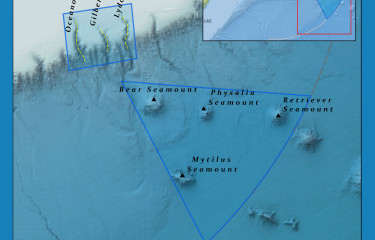The prohibition of fishing in the area that became the Northeast Canyons and Seamounts Marine National Monument had little to no negative impact for squid/butterfish, mackerel, and tuna fisheries, according to a recent study published in the scientific journal Nature.
The study, "Fishing activity before closure, during closure, and after reopening of the Northeast Canyons and Seamounts Marine National Monument," was authored by John Lynham, a professor of economics at the University of Hawai'i at Mānoa.
Lynham found that the activity of three fisheries before closure, during closure, and after reopening of the Northeast Canyons and Seamounts Marine National Monument suffered little impact.
The monument, a marine protected area (MPA) located off the east coast of the U.S. – roughly 170 kilometers southeast of Massachusetts' Nantucket Island – is the only national monument in U.S. Atlantic waters and encompasses 12,275 square kilometers. It was created 15 September, 2016, by then-President Barack Obama, with a two-month delay before commercial fishing was banned. The monument was then reopened to legally permitted fishing operations on 5 June, 2020, by then-President Donald Trump. Then, on 8 October, 2021, U.S. President Joe Biden reversed the reopening, reinstating a ban on commercial fishing in the monument.
The monument's creation was the subject of lawsuits by fishermen who objected to being excluded from the area. MPAs are intended to protect areas of ocean space with the intention of benefitting species within its boundaries. The economic impact to fishers was a leading argument from industry to challenge MPA designations.
After the creation of the monument, most forms of commercial fishing were banned, except for lobster and red crab, which are being phased out over a seven-year period.
The study reported on three major fisheries that had the highest potential to be adversely affected by fishing closures: the squid/butterfish trawl fishery (longfin/loligo squid), the Atlantic mackerel trawl fishery, and the Atlantic tuna/swordfish longline fishery, which includes North Atlantic albacore tuna, Atlantic skipjack tuna, Atlantic bigeye tuna, Western Atlantic bluefin tuna, and Atlantic yellowfin tuna.
The study looked at catch reports and vessel tracking for four time periods: before the announcement of the MPA, after the announcement but before the closure, after closure, and after reopening.
The study found less than 1 percent of historical fishing grounds for the fisheries analyzed were lost due to the monument. That leaves more than 99 percent of locations that vessels used before the ban still open for fishing.
Catch totals did not appear to have declined in the three fisheries, as pounds landed have not gone down for squid, butterfish, mackerel, and tuna/swordfish.
Additionally, none of the potentially impacted fleets had to travel further to fish after the monument was closed, which was identified by studying averaging monthly distances traveled as observed via vessel-tracking systems.
And with closing, reopening, and second closing of the fishing grounds, there was no increase in catch, reduction of distance traveled, or increase in relative fishing effort inside the monument for any of the fisheries studied.
The paper also addresses claims that as many as 80 vessels regularly fished in the monument and that a commercial fishing prohibition in the area would reduce yield and inflict economic harm on fisheries, finding that yields have not yet been impacted.
Detractors of the monument have claimed its creation would lead to a “blue paradox” effect, where anticipation of an MPA catalyzed a “race-to-fish” that would undermine conservation efforts. However, the study found Obama's announcement of the creation of the monument did not spur additional fishing activity.
Overall, the monument has caused little to no disruption in the squid/butterfish, mackerel, or tuna fisheries, nor did reopening it provide much tangible economic benefit to the fisheries, according to data on landings and vessel movements.
Though the debate continues over the long-term and short-term impacts of MPAs on fisheries – with the Biden administration committing to a “30 by 30” goal to project 30 percent of the U.S. exclusive economic zone in some form by 2030 – the study concludes the creation of Northeast Canyons and Seamounts Marine National monument as an MPA had little economic impact on fisheries, but may have many unknown and possibly positive outcomes that as a result of its creation.
Image courtesy of NOAA







